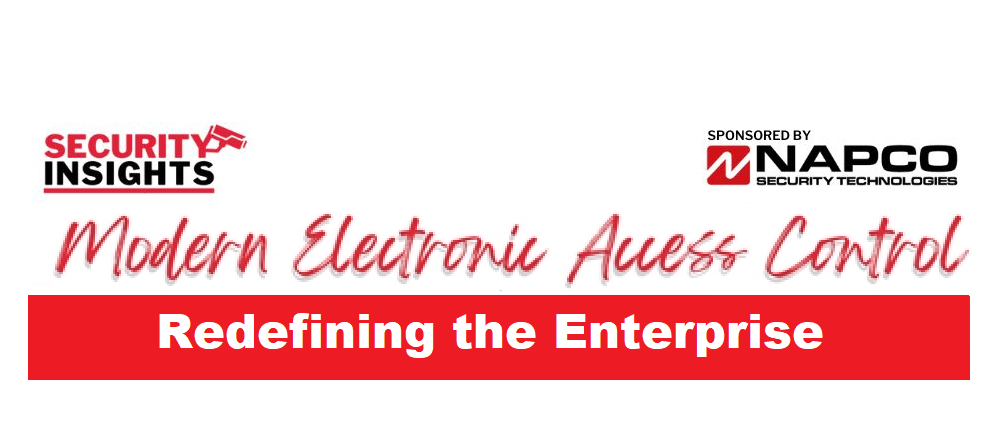SSN Access Control Webcast – Wrestling with the legacy to define modern electronic access control
By Ken Showers, Managing Editor
Updated 2:33 PM CDT, Wed June 12, 2024

YARMOUTH, Maine — The advent of 2020 marked a change in the development of electronic access control as we know it, with systems evolving to meet the needs of a modern era.
Security Systems News’ latest webcast, “Modern Electronic Access Control: Redefining the Enterprise,” gathered together expert panelists to explore the changing shape of electronic access control. The panelists discussed and shared their insights on topics like the changing requirements & expectations for enterprise access control, how the approach to access control design and deployment has pivoted, evaluating and implementing modern access control solutions, and future-proofing strategies to stay ahead of the curve.
Among the industry professionals welcomed to the webcast were: Lee Odess, CEO, Access Control Executive Brief; Robert Lydic, president, WaveLynx; Maureen Perrelli, chief revenue officer, Brivo; and Manish Dalal, president and founder, ZKTECO USA. The webcast was moderated by Security Systems News (SSN) Editor Cory Harris.
Odess took the reins at the start of the webcast to set the tone for the discussion. “So, let's just say if we level-set a little bit by the title of this being around modern electronics access control, that clearly means we're trying to drive the differentiation between the legacy in a lot of ways, and I do want to mention that it doesn't mean that one is bad and one is good. It just means that they're different and it's my belief, and many others, that 2020 was sort of a delineation point where we moved to modern electronic access control.”
Key factors driving change
Odess went on to ask panelists what the key factors driving changing requirements and expectations for enterprise access control systems were from 2020 onwards.
“Today the customer wants everything interoperable interchangeable or service seamless integrations using APIs and the data should flow between the different systems, the different edge devices, even turnstiles, or even if they have metal detectors, everything needs to now transmit data to a single dash,” said Dalal.
“I think they're led by the need for identity,” added Lydic. “The need for end users to actually know who's entering their door. Somehow, we've enabled ourselves to absolutely validate that for our logical access systems, things that we log into like we're logged into this go to webinar today. We're providing some form of identity there in our internal workings. We're doing the same thing for accessing our Microsoft or our Google (accounts) with two factor authentication. That, and the enterprise, is driving a lot of conversations.”
“I think on the enterprise side, a lot of it is being driven by what the company is doing as a whole,” Perrelli noted. “It's not just about the security side of it, it's about what IT does as well and how you can integrate those into the business to see those advanced technologies. For me, when I look at enterprise, I think about certainly, the cybersecurity with increasing digitization of access control systems becoming more of a significant conversation around the enterprise. I think of compliance requirements that are required when you look globally to work and how access control can help do that and integrate within the systems.
She concludes, “That enterprise space is really seeking access control systems that can, I would say, seamlessly integrate with other security and business systems to make it easier for their customers to be able to access and then take advantage of that security and that technology to make it easier to do business across the entire platform of that company.”
Design and deployment
Odess then asked panelists to describe how business approaches to access control design and deployment have pivoted in response to those changes.
“So, the first is the adoption of cloud-based solutions,” Perrelli began. “On the IT side of the house it is very common. But as I've been over on this side of the house for the past several years, on the security side of the cloud-based access control systems truly are gaining more and more traction because of the scalability and flexibility and the ease of remote management to be able to have that approach into that design.”
“I like to be a bit contrarian here, and in general it's just I think it might be how I'm wired,” Lydic said. “I would look at how we're doing design and deployment and I look to our engineer, architect, friends and I look to the installers and they're lagging, quite frankly in many cases. Maureen says, ‘Hey, we've been doing cloud access control for 20 years,’ and that's completely legit. And the fact that our design community and the installer community are finally getting comfortable with this because the reality is it takes a different skill set in today's architecture. It takes a different skill set of the engineers, architects and friends that it's not a boilerplate spec anymore. It doesn't say do these 15 things that were from 1982.”
Dalal rounded out the question, saying, “I would like to add to what MU and Rob said earlier. It's very true. You know these Division 8 specifications, which are copied and pasted from the data sheets and brochures of all the traditional access control systems’ needs, need a big overhaul. And I don't know how many companies actually follow them.” He goes on to add, “Being on the road, meeting a lot of customers, I'm just surprised that the level of the expertise has scaled up so much that it's very heartening for companies like us who are always, you know, forward thinking and progressing to see that. Finally, we'll have a customer base who will understand and implement this technology in the right way.”
This article has been edited for clarity and length. You can find the full webcast online at www.securitysystemsnews.com/webcasts.
Comments